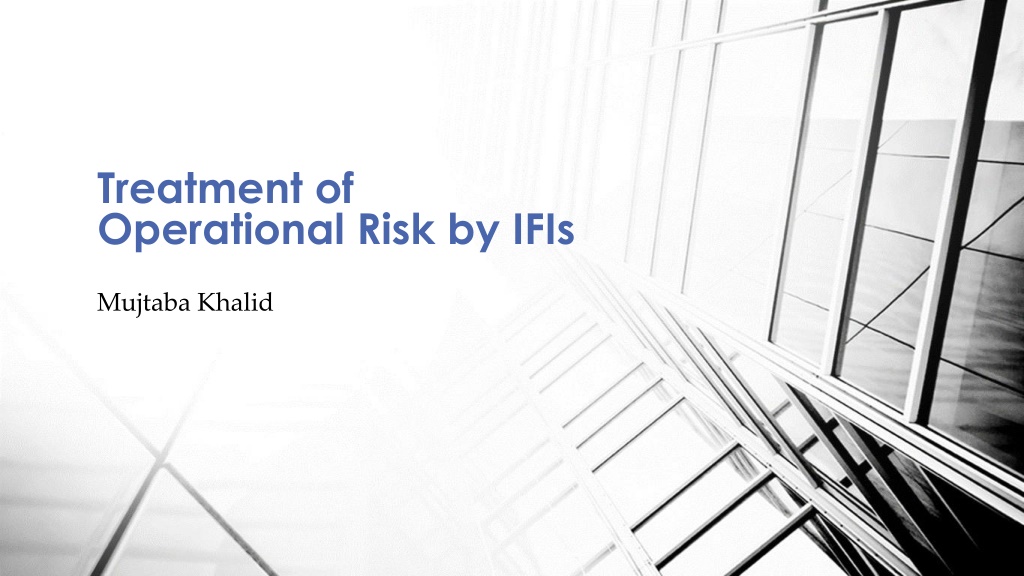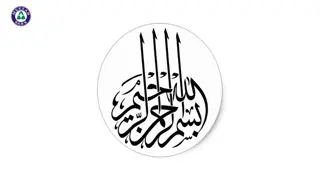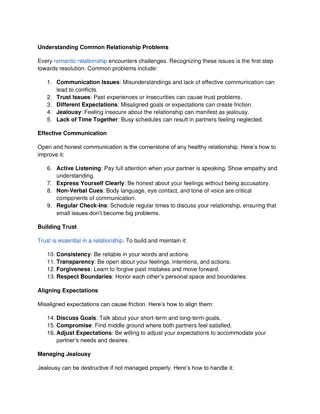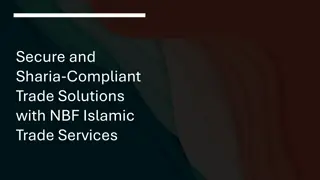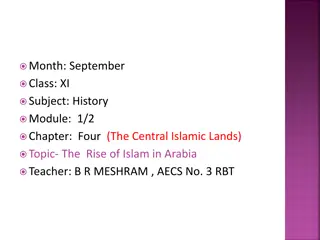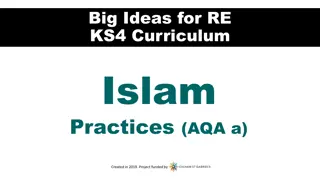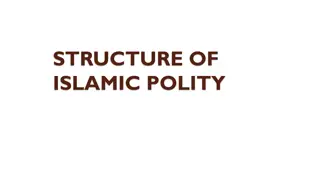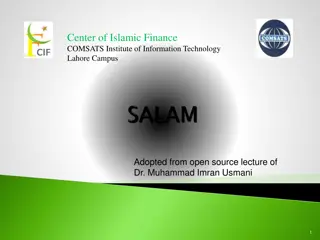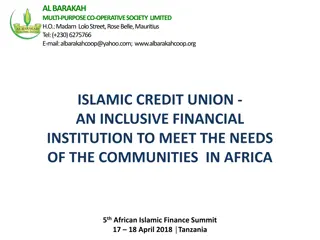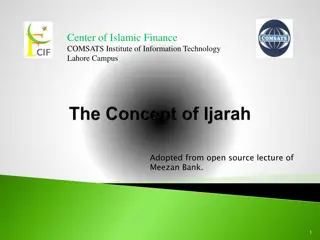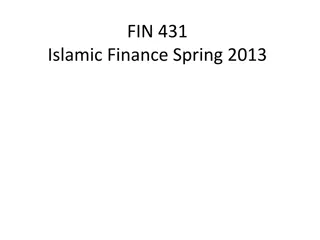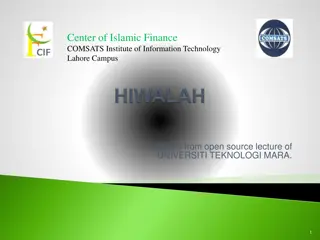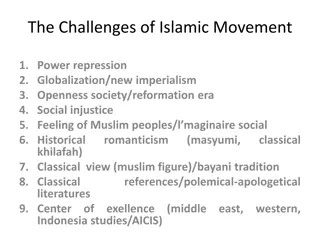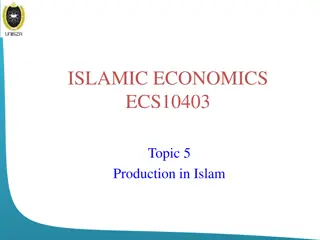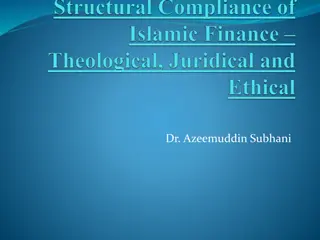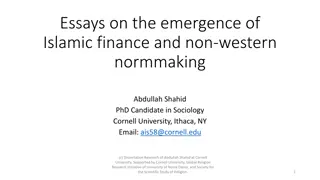Understanding Risk Management in Islamic Finance Institutions
Islamic Financial Institutions (IFIs) face various types of risks, including Shariah compliance, rate of return, displaced commercial equity investment, and operational risks. This content delves into how IFIs manage these risks through Shariah auditing, risk management for financial contracts, and asset-based financing products like Murabahah and Ijarah. It also explores the different types of financial contracts in Islamic banking and the components of Islamic financial statements.
Uploaded on Oct 10, 2024 | 0 Views
Download Presentation

Please find below an Image/Link to download the presentation.
The content on the website is provided AS IS for your information and personal use only. It may not be sold, licensed, or shared on other websites without obtaining consent from the author. Download presentation by click this link. If you encounter any issues during the download, it is possible that the publisher has removed the file from their server.
E N D
Presentation Transcript
Treatment of Operational Risk by IFIs Mujtaba Khalid
Summary Islamic Financial Institutions and Risk Shariah Auditing Shariah Risk Management for Common Islamic Financial Contracts
Types of Risks Faced by Financial Institutions Shariah non- compliance Rate of return Displaced Commercial Equity Investment Unique Islamic Banks Generic Liquidity Operational Market Credit 4
Understanding Contractual Relationships in Islamic Banking Terms Conventional Islamic Deposits Lender/Borrower Custodian / Entrepreneur Financier / Capital Provider Safe Custody (Wadiah) Investment / Profit Sharing (Mudarabah) Interest Based Deposits Interest Based Loans Debt Financing (Bai Bithaman Ajil, Murabahah) Equity Financing/ Profit Sharing (Musharakah /Mudarabah) Trading (Buy & Sell - Bai) Financing Lending/Borrowing
Understanding Islamic Financial Statements One Stop Shopping Bank LIABILITIES ASSETS Cash & cash equivalents Current accounts Sales receivables Other liabilities Investment in securities Equity of Profit Sharing Investment Accounts (PSIA) Buying physical assets before selling Investment in leased assets Investment in real estate Direct equity investment Profit Sharing Investment Accounts (PSIA) Equity investment in joint ventures Leasing and trading in real estate Equity investment in capital ventures Profit equalization reserve Inventories Fund management Investment risk reserve Other assets Investment in Sukuk Owners Equity Fixed assets Off-balance sheet assets
IFIs and Risk The asset-based nature of financing products in IFIs such as Murabahah, Salam, Istisna and Ijarah may give rise to additional forms of operational risk in contract drafting and execution that are specific to such products. And also Investing modes Mudarabah and Musharakah.
Operational Risks IFI Specific Non-compliance with Shariah rules and principles in the IFIS operations Fund Provider s Withdrawal Loss of Income Voiding of Contracts Shariah Non- Compliance Risk Leading to diminished reputation, limited business opportunities, financial losses etc. IFI Specific Operational Risk Fiduciary Risk IFI s fiduciary responsibilities as Mudarib towards fund providers
Shariah Non-compliance in Financial Transactions Contractual Form of the Transaction Underlying Shariah contract Legal Documentation Financial Transaction
Shariah Non-Compliance with Respect to Credit Risk and Default - Example Investment Dar Co KSSC v Blom Development Bank Sal [2009] - Sukuk Default Kuwait's troubled shareholding company The Investment Dar (TID) refused to pay Lebanon's Blom Bank USD $10.7 million, saying that their original deal did not comply with Islamic law According to a legal brief circulated, Blom sued the company in a British court, asking for the principal it invested plus a 5% return, as structured in a deal it conducted with Dar in 2007 Ironically, TID argued that the Wakalah agreement which was approved by its own Shariah board did not comply with the Shariah and was therefore void because it was against TID s constitutional documents. The contract called for the company to return the principal investment plus a fixed profit a deal Dar's attorneys said constituted interest, which is prohibited under Shariah law The learned judge agreed that the issue of Shariah compliance needed to go to trial for proper deliberation, but considering the deposit, TID still had to pay the amount deposited of USD 10,733,292.55 to the BDB. Due to various reasons, the case was withdrawn.
Illustrative Example of Shariah Non- Compliance Foreclosure case against the defaulting customer If an Islamic bank files a lawsuit against a customer who has defaulted on Murabahah payments, the judgment may be turned in favor of the defendant (i.e., customer) such as the case of Arab Malaysian Finance Bhd v Taman Ihsan Jaya Sdn Bhd & Orswhen the Judge ruled the contracted BBA (Murabahah) as a non bona fide sale because it constitutes a financing facility with a charge agreement. As the contract is void, the customer was to only give back the principle amount advanced by the bank. This also means that the bank had to return any profit it had acquired from the customer, if total payments at default exceeded the original amount.
Explanation Conventional Bank Omar is keen to purchase a $ 200,000 apartment. He meets the developer/vendor and signs a Sale and Purchase agreement (S&P) after placing a 10% down payment, $ 20,000. Omar seek to borrow the remaining sum of $ 180,000 from a conventional bank. On approval of the loan, $ 180,000 is paid to the developer. Omar will pledge the property as collateral via the charge agreement on the $ 180,000 loan. Assuming the interest rate is at a flat 4% over 20 years, Omar will pay the bank $ 144,000 in interest. Monthly instalment = (180,000 + 144,000) / 240 = $ 1,350.
Explanation Islamic Bank The transaction becomes complicated when an Islamic Bank is not involved in the sale and purchase agreement (S & P) with Omar How can an Islamic bank observe the rules of Murabahah (to sell the property to Omar) when in the first place, it does not own the asset? The Holy Prophet (s.a.w.) says, Do not sell what you do not own. How to overcame this Shariah stipulation? To observe this Shariah rule, the Islamic bank purchases the property from Omar via the Property Purchase Agreement (PPA for $ 180,000). The bank makes the $ 180,000 disbursement to Omar, which it passes on to the developer. Once the Islamic bank holds ownership via PPA, it then sells the property to Omar via the Property Sale Agreement (PSA).
Measuring the Cost of Shariah Non- Compliance Building on from the previous example, we can deduce three cases: CASE A The paid amount is less than the original facility, e.g. 75 monthly payments before defaulting. CASE B The paid amount is equal to the original facility e.g. 134 monthly payments before defaulting. CASE C The paid amount is more than the original facility, e.g. 185 monthly payments before defaulting.
Case A Omar seeks to borrow the remaining sum of $ 180,000 from an Islamic bank. Assuming the Ijarah rate is at a flat 4% over 20 years, Omar will pay the bank $ 144,000 in interest. Monthly instalment = (180,000 + 144,000) / 240 = $ 1,350 Omar has paid $101,250 (75 months monthly instalment) before defaulting. The outstanding balance is $ 222,750. However, the court has ruled the nullification of Murabahah and the profit elements of the 75 instalments paid are to be clawed back and returned back to the customer. Calculate Principal and Profit portion of payment, Payment made to Bank, Loss to Bank
Calculations Financing/Principal: $ 180,000 + Profit = $ 144,000 Selling price = $ 324,000 Tenure = 20 years; Number of installment payments = 240 Monthly Payment = $ 1,350; Principal = $ 750, Profit = $ 600 Payment before default = $ 101,250 (75 monthly payments); Principal = $ 750 x 75 = $ 56,250; Profit = $600 x 75 = $ 45,000 Outstanding balance = $ 1,350 x 165 months = $ 222,750. Remaining Balance for Omar to pay: $ 180,000 $ 101,250 = $ 78,750 Loss to the bank: $ 45,000 to be clawed back from actualized earnings to be paid to charity. S & P agreement: Title of the property still with the client.
Case B Omar seeks to borrow the remaining sum of $ 180,000 from an Islamic bank. Assuming the Ijarah rate is at a flat 4% over 20 years, Omar will pay the bank $ 144,000 in interest. Monthly instalment = (180,000 + 144,000) / 240 = $ 1,350 Omar has paid $180,900 (134 months monthly instalment) before defaulting. The outstanding balance is $143,100. However, the court has ruled the nullification of Murabahah and the profit elements of the 134 instalments paid are to be clawed back and returned back to the customer. Calculate Principal and Profit portion of payment, Payment made to Bank, Loss to Bank
Calculations Financing/Principal: $ 180,000 + Profit = $ 144,000 Selling price = $ 324,000 Tenure = 20 years; Number of installment payments = 240 Monthly Payment = $ 1,350; Principal = $ 750, Profit = $ 600 Payment before default = $ 180,900 (134 monthly payments); Principal = $ 750 x 134 = $ 100,500; Profit = $ 600 x 134 = $ 80,400 Outstanding balance = $ 1,350 x 106 months = $ 143,100. Bank to pay Omar: $ 180,000 $ 180,900 = $900 Loss to the bank: $80,400 to be clawed back from actualized earnings to be paid to charity. S & P agreement: Title of the property still with the client.
Case C Omar seeks to borrow the remaining sum of $ 180,000 from an Islamic bank. Assuming the Ijarah rate is at a flat 4% over 20 years, Omar will pay the bank $ 144,000 in interest. Monthly instalment = (180,000 + 144,000) / 240 = $ 1,350 Omar has paid $ 249,750 (185 months monthly instalment) before defaulting. The outstanding balance is $74,250. However, the court has ruled the nullification of Murabahah and the profit elements of the 185 instalments paid are to be clawed back and returned back to the customer. Calculate Principal and Profit portion of payment, Payment made to Bank, Loss to Bank
Calculations Financing/Principal: $ 180,000 + Profit = $ 144,000 Selling price = $ 324,000 Tenure = 20 years; Number of installment payments = 240 Monthly Payment = $ 1,350; Principal = $ 750, Profit = $ 600 Payment before default = $ 249,750 (185 monthly payments); Principal = $ 750 x 185 = $ 138,750; Profit = $ 600 x 185 = $ 111,000 Outstanding balance = $ 1,350 x 55 months = $ 74,250. Bank to payback Omar = $249,750 - $ 180,000 = $ 69,750 Loss to the bank: $111,000 to be clawed back from actualized earnings to be paid to charity. S & P agreement: Title of the property still with the client.
Fiduciary Risk A fiduciary duty is a legal duty to act in another party's interests. Parties owing this duty are called fiduciaries. The individuals to whom they owe a duty are called principals. AAOIFI (1999) defines fiduciary risk as being legally liable for a breach of the investment contract either for noncompliance with Shariah rules or for mismanagement of investors funds. Fiduciary risk also exposes equity holders and investment depositors to the risk of economic losses, as they would not receive their share of the profits.
Fiduciary Risk Occurrence Fiduciary Risk Partnership based investments In the case of Mudarabah and Musharakah investments on the asset side, the bank is expected to perform adequate screening and monitoring of projects. Any intentional negligence in evaluating or monitoring the project can lead to fiduciary risk Mismanagement of funds of current account holders having being accepted on a trust (Ammanah) can expose the bank to fiduciary risk. IBIs use funds of current account holders without being obliged to share profits. Mismanagement In governing the business by incurring unnecessary expenses or allocating excessive expenses to investment account holders is breach of implicit contract to act in a transparent fashion
Shariah Auditing According to GSIFI 2 of AAOIFI, Shariah Review is an examination of the extent of an IFI s compliance, in all its activities, with the Shariah. This examination includes contracts, agreements, policies, products, transactions, memorandum and articles of association, financial statements, reports (especially internal audit and central bank inspection), circulars, etc. The objective of a Shariah review is to ensure that the activities carried out by an IFI do not contravene the Shariah. While the SSB is responsible for forming and expressing an opinion on the extent of an IFI s compliance with the Shariah, the responsibility for compliance therewith rests with the management of an IFI
Zakat Calculation & Payment Human Resource Management Contracts and Agreements Scope of Shariah Audit Environmental Impact Business Policies Marketing and Advertisement
The Risk Management Process Involve all relevant parties Identification Continuous cycle Revisit regularly Assessment Review Impact Likelihood Management Develop strategies Channel resources
Managing Operational Risk Employee training Close management oversight Segregation of duties Employee background checks Implementing proper procedures and processes Purchase of insurance Exiting certain businesses
Shariah Non-Compliance Risk Management Do the terms of the transaction comply with Shariah Law? Is this the best investment option for the client? Does the investment produce value for the client and for the community in which the client is active? As an asset manager, is this a transaction in which the banker as an individual is also willing to invest? If the answer to any of the above is no, the proposed transaction should be rejected
Mudarabah Deposits Stage Shariah Non-Compliance Risk The bank cannot contract to provide a fixed return on deposits Contract Reserve maintenance risk The bank should ensure an adequate return to protect deposit holders and bank s shareholders. Both the Profit Equalization and Investment Risk Reserves should be managed diligently The bank must insure that the rate of return paid back to deposit holders takes into account the added equity risk taken by deposit holders and is attractive compared to other options in the market Profit Attribution AAOIFI standards require Islamic banks to present the depositor s fund as a form of equity, therefore may banks face complex issues in application of prudential reserve requirements. Restricted investment account holders have to be shown in an off balance sheet statement Presentation
Ijarah Shariah Risk Management Stage Shariah Non-Compliance Risk Agreement to Lease Promise (Binding) Lease of consumables The Islamic Bank should not enter into a lease of consumables or edible commodities Order/Receipt of Asset No rental should be applicable before delivery of asset to the customer Ownership Transfer Ownership to be transferred at end of the lease period. If ownership has been transferred, rentals on such assets would be equivalent to charging interest on financing Contract Non-Existent Asset Entering into a lease of non-existent asset may lead to disputes Late Payment A lessee may undertake to donate to charity a certain percentage of the rental incase of late payment, however, no late payment penalty may be charged to the bank Mutual Dissolution additional cost of providing an alternate asset maybe borne by the Islamic bank, if the leased asset is destroyed without negligence. Rejected/ Defective Asset Default The Islamic bank may not charge any penal interest in case of default in payment.
Steps Post Shariah Non-Compliance Identification Where an institution becomes aware that it is carrying on any of its business in a manner which is not in compliance with Shariah the institution shall (a) Notify the bank s Shariah committee of the fact; (b) Immediately cease from carrying on such business, affair or activity and from taking on any other similar business, affair or activity; and (c) Submit a plan on the immediate rectification of the non-compliance. The bank should carry out an future assessments as it thinks necessary to determine whether the non-compliance has been rectified
